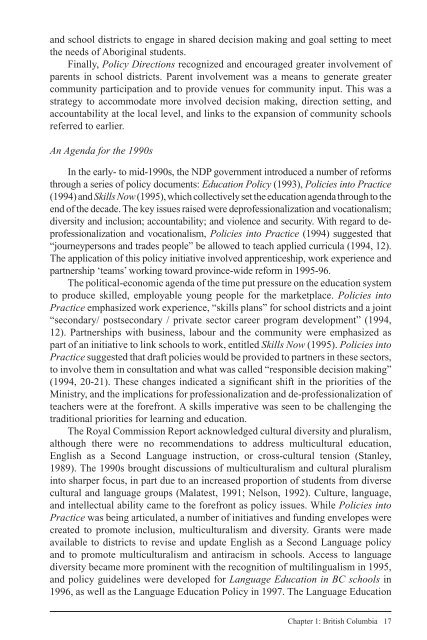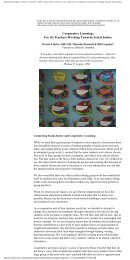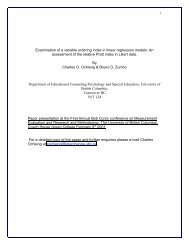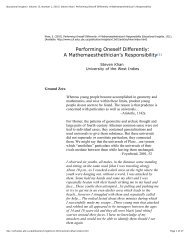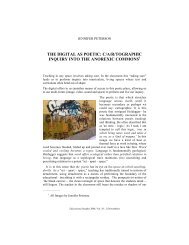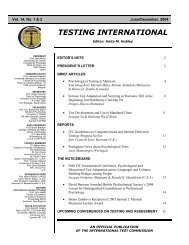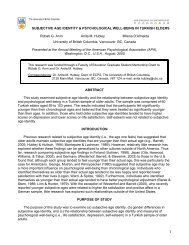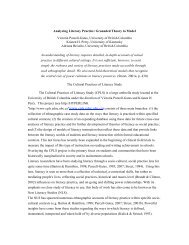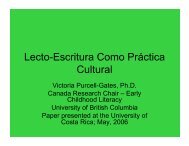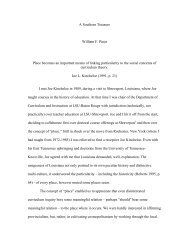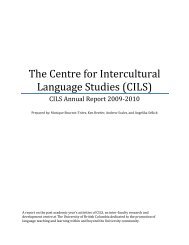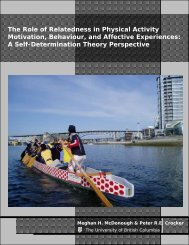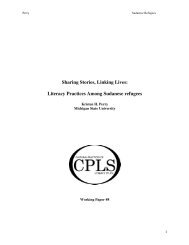The evolution of professionalism - Centre for Policy Studies in ...
The evolution of professionalism - Centre for Policy Studies in ...
The evolution of professionalism - Centre for Policy Studies in ...
Create successful ePaper yourself
Turn your PDF publications into a flip-book with our unique Google optimized e-Paper software.
and school districts to engage <strong>in</strong> shared decision mak<strong>in</strong>g and goal sett<strong>in</strong>g to meet<br />
the needs <strong>of</strong> Aborig<strong>in</strong>al students.<br />
F<strong>in</strong>ally, <strong>Policy</strong> Directions recognized and encouraged greater <strong>in</strong>volvement <strong>of</strong><br />
parents <strong>in</strong> school districts. Parent <strong>in</strong>volvement was a means to generate greater<br />
community participation and to provide venues <strong>for</strong> community <strong>in</strong>put. This was a<br />
strategy to accommodate more <strong>in</strong>volved decision mak<strong>in</strong>g, direction sett<strong>in</strong>g, and<br />
accountability at the local level, and l<strong>in</strong>ks to the expansion <strong>of</strong> community schools<br />
referred to earlier.<br />
An Agenda <strong>for</strong> the 1990s<br />
In the early- to mid-1990s, the NDP government <strong>in</strong>troduced a number <strong>of</strong> re<strong>for</strong>ms<br />
through a series <strong>of</strong> policy documents: Education <strong>Policy</strong> (1993), Policies <strong>in</strong>to Practice<br />
(1994) and Skills Now (1995), which collectively set the education agenda through to the<br />
end <strong>of</strong> the decade. <strong>The</strong> key issues raised were depr<strong>of</strong>essionalization and vocationalism;<br />
diversity and <strong>in</strong>clusion; accountability; and violence and security. With regard to depr<strong>of</strong>essionalization<br />
and vocationalism, Policies <strong>in</strong>to Practice (1994) suggested that<br />
“journeypersons and trades people” be allowed to teach applied curricula (1994, 12).<br />
<strong>The</strong> application <strong>of</strong> this policy <strong>in</strong>itiative <strong>in</strong>volved apprenticeship, work experience and<br />
partnership ‘teams’ work<strong>in</strong>g toward prov<strong>in</strong>ce-wide re<strong>for</strong>m <strong>in</strong> 1995-96.<br />
<strong>The</strong> political-economic agenda <strong>of</strong> the time put pressure on the education system<br />
to produce skilled, employable young people <strong>for</strong> the marketplace. Policies <strong>in</strong>to<br />
Practice emphasized work experience, “skills plans” <strong>for</strong> school districts and a jo<strong>in</strong>t<br />
“secondary/ postsecondary / private sector career program development” (1994,<br />
12). Partnerships with bus<strong>in</strong>ess, labour and the community were emphasized as<br />
part <strong>of</strong> an <strong>in</strong>itiative to l<strong>in</strong>k schools to work, entitled Skills Now (1995). Policies <strong>in</strong>to<br />
Practice suggested that draft policies would be provided to partners <strong>in</strong> these sectors,<br />
to <strong>in</strong>volve them <strong>in</strong> consultation and what was called “responsible decision mak<strong>in</strong>g”<br />
(1994, 20-21). <strong>The</strong>se changes <strong>in</strong>dicated a signifi cant shift <strong>in</strong> the priorities <strong>of</strong> the<br />
M<strong>in</strong>istry, and the implications <strong>for</strong> pr<strong>of</strong>essionalization and de-pr<strong>of</strong>essionalization <strong>of</strong><br />
teachers were at the <strong>for</strong>efront. A skills imperative was seen to be challeng<strong>in</strong>g the<br />
traditional priorities <strong>for</strong> learn<strong>in</strong>g and education.<br />
<strong>The</strong> Royal Commission Report acknowledged cultural diversity and pluralism,<br />
although there were no recommendations to address multicultural education,<br />
English as a Second Language <strong>in</strong>struction, or cross-cultural tension (Stanley,<br />
1989). <strong>The</strong> 1990s brought discussions <strong>of</strong> multiculturalism and cultural pluralism<br />
<strong>in</strong>to sharper focus, <strong>in</strong> part due to an <strong>in</strong>creased proportion <strong>of</strong> students from diverse<br />
cultural and language groups (Malatest, 1991; Nelson, 1992). Culture, language,<br />
and <strong>in</strong>tellectual ability came to the <strong>for</strong>efront as policy issues. While Policies <strong>in</strong>to<br />
Practice was be<strong>in</strong>g articulated, a number <strong>of</strong> <strong>in</strong>itiatives and fund<strong>in</strong>g envelopes were<br />
created to promote <strong>in</strong>clusion, multiculturalism and diversity. Grants were made<br />
available to districts to revise and update English as a Second Language policy<br />
and to promote multiculturalism and antiracism <strong>in</strong> schools. Access to language<br />
diversity became more prom<strong>in</strong>ent with the recognition <strong>of</strong> multil<strong>in</strong>gualism <strong>in</strong> 1995,<br />
and policy guidel<strong>in</strong>es were developed <strong>for</strong> Language Education <strong>in</strong> BC schools <strong>in</strong><br />
1996, as well as the Language Education <strong>Policy</strong> <strong>in</strong> 1997. <strong>The</strong> Language Education<br />
Chapter 1: British Columbia 17


